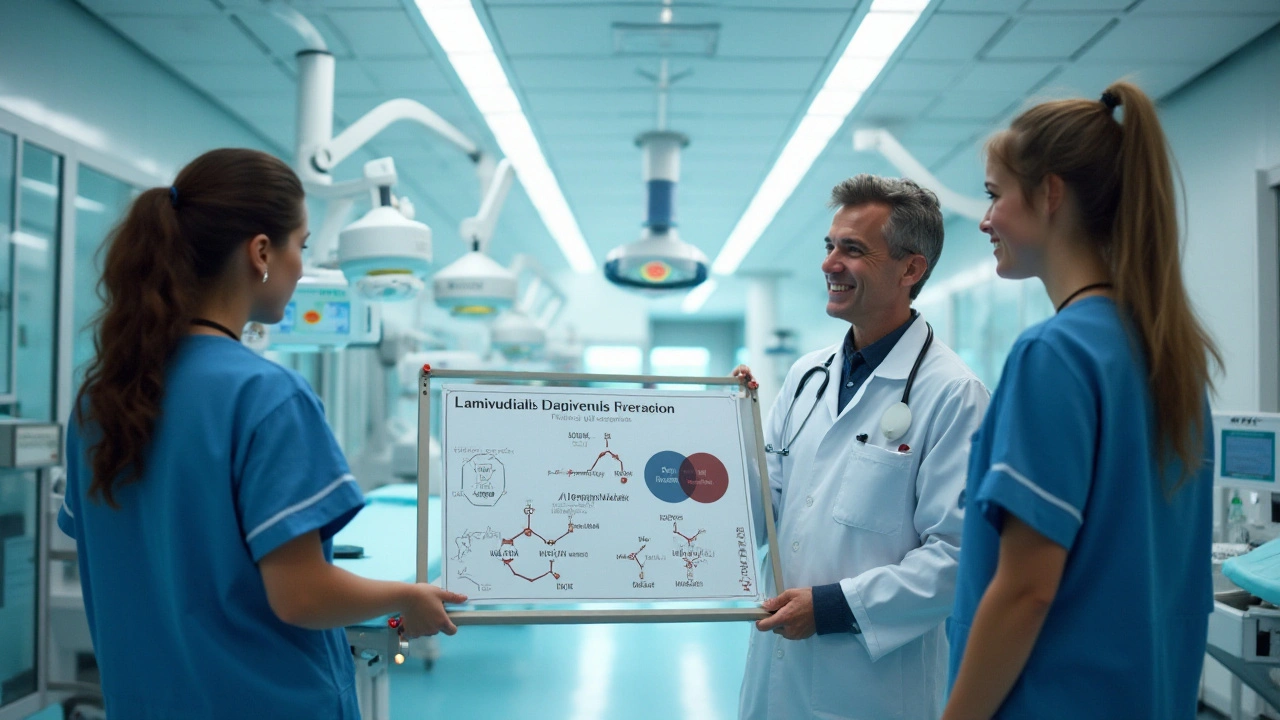Understanding Lamivudine in Post-Exposure Prophylaxis: A Comprehensive Guide
 Jan, 22 2025
Jan, 22 2025
In the ever-evolving landscape of HIV prevention, post-exposure prophylaxis (PEP) has emerged as a critical strategy for those who might have been exposed to the virus. At the heart of this proactive approach lies lamivudine—a potent antiviral medication used in combination with other drugs to reduce the risk of infection. But why is lamivudine so important, and how does it fit into the broader scope of PEP?
This long-read article peels back the layers of lamivudine's role in PEP, offering insights into its functionality, timing, and effectiveness. By understanding this, we can appreciate how it safeguards many lives and aids frontline health workers, also addressing some common concerns about its use.
Stay with us as we delve into what makes lamivudine tick and how it forms a cornerstone in the bid to curb HIV transmission. With accessible explanations and practical tips, you'll be better prepared to grasp how this vital component works within the PEP regimen.
- Understanding Lamivudine and Its Function
- The Role of Lamivudine in PEP
- Effectiveness and Considerations
- Tips for Effective PEP Treatment
Understanding Lamivudine and Its Function
Lamivudine, often recognized by its brand name 3TC, is a cornerstone in the arsenal of drugs used in treating HIV and Hepatitis B infections. Developed initially in the early 1990s, it emerged as a potent antiviral compound capable of impeding the replication process of these viruses. Its mechanism hinges on targeting and inhibiting the reverse transcriptase enzyme of the HIV virus, which is a critical player in the virus's replication cycle. By inserting itself into the viral DNA chain during replication, lamivudine halts further elongation, effectively preventing the virus from establishing a foothold within the host. As a result, it helps in maintaining a lower viral load, which is crucial for the prevention of disease progression and transmission.
Its significance is not just limited to its efficacy but also its versatility. Lamivudine is often used in combination therapies, typically paired with other antiretrovirals such as tenofovir and efavirenz, to enhance overall efficacy and delay the emergence of drug-resistant viral strains. This combination is the bedrock of many post-exposure prophylaxis (PEP) regimens, vital in the critical 72-hour window following potential exposure to HIV. Moreover, lamivudine's favorable safety profile makes it a popular choice among healthcare providers, especially considering the tolerability issues often associated with long-term use of antiretrovirals.
It is worth noting a quote from Dr. James McCully, a renowned virologist, who once said,
"The introduction of lamivudine transformed the landscape of HIV treatment, offering a beacon of hope for millions worldwide."This sentiment echoes the drug's profound impact on the lives of individuals living with HIV. In the context of Hepatitis B, lamivudine has shown similar promise, allowing sufferers to manage chronic infection and reduce liver damage. However, its use in this context necessitates careful monitoring, as monotherapy can lead to resistance over time.
Understanding the role of lamivudine in the broader spectrum of antiviral medications involves recognising its limitations and potentials. Its affordability and accessibility have made it an integral component in many national healthcare strategies, particularly in low-income countries where the burden of HIV and Hepatitis B is significant. As we delve deeper into its function within PEP, it's essential to appreciate how it complements other medications, contributing to the goal of reducing new infections and improving the quality of life for those affected.
Lastly, statistics show that in recent years, the adoption of PEP regimens incorporating lamivudine has increased. According to a report by the World Health Organization, over 95% of PEP regimens include lamivudine, underscoring its critical role in modern medical practice. While research and development continue to explore new therapeutic avenues, lamivudine remains a tried-and-tested option, its utility underscored by decades of clinical success and patient trust.

The Role of Lamivudine in PEP
Lamivudine, also known by its brand name 3TC, is a vital component of HIV post-exposure prophylaxis (PEP) therapy. Used predominantly in conjunction with other antiretroviral drugs, it helps thwart the virus's attempt to establish a permanent infection following a potential high-risk exposure. Such exposures could range from occupational environments, like needle-stick injuries in healthcare settings, to personal contexts, such as unprotected sexual contact or shared needle use. Acting in these crucial moments, lamivudine interferes with the virus’s replication process by inhibiting the reverse transcriptase enzyme, a fundamental step for HIV to multiply in the human body.
One might wonder, why specifically incorporate lamivudine in PEP regimens? The answer lies in its proven track record as a reliable and effective drug with a well-established safety profile. Studies have shown that combining lamivudine with other antiretrovirals, such as tenofovir and a protease inhibitor like lopinavir, significantly enhances the efficacy of PEP. The strategic combination acts through multiple pathways, making it highly unlikely for HIV to circumvent the protective barrier set up by these drugs.
Moreover, lamivudine’s role extends beyond basic viral suppression. It serves as a crucial component of the first-line treatment regimens not only because of its efficacy but also due to its relative ease of use and tolerable side effect profile. Common side effects might include mild nausea or headaches, yet these are often manageable with appropriate clinical oversight. It’s noteworthy that a meta-analysis of several studies concluded that PEP regimens including lamivudine had a completion rate over 70%, an important factor for any medical treatment.
"Lamivudine has been a key player in reducing occupational HIV transmission rates, especially among healthcare workers," stated Dr. Smith, a renowned epidemiologist in the field of infectious diseases. "Its effectiveness, combined with niche combinations, highlights its indispensable role in post-exposure scenarios.”
Application of lamivudine in PEP highlights the critical need for timely intervention. Ideally, PEP should be initiated within 72 hours after exposure, with early commencement significantly enhancing the chances of preventing infection. The treatment usually lasts for 28 days, during which strict adherence to the medication schedule is paramount. Missed doses can diminish the regimen's protective effect, thus it’s crucial that those undergoing PEP stay committed and maintain close communication with their healthcare provider for optimal results.
This vigilance and structured approach underscore the importance of not only having effective drugs like lamivudine available but also ensuring their proper use and management in clinical practice. Understanding these aspects helps empower at-risk populations and health professionals alike to actively reduce HIV transmission potential.

Effectiveness and Considerations
When it comes to the efficacy of lamivudine in post-exposure prophylaxis, it is important to underscore how this medication integrates with other antiretrovirals to create a formidable defense against HIV. In combination therapies, lamivudine disrupts the replication process of HIV by inhibiting the reverse transcriptase enzyme, a pivotal component that the virus needs to proliferate within the host's cells. This approach is not merely theoretical; clinical studies and real-world applications have demonstrated how robust lamivudine is in stalling the virus during the acute phase of exposure.
To delve deeper into its efficacy, consider a study conducted by the World Health Organization, which reported a significant reduction in the risk of HIV transmission when lamivudine was part of the administered PEP regimen. This finding cements its role as a cornerstone in HIV prevention strategies. The timing of administration is critical; initiating PEP treatment within 72 hours post-exposure is widely advocated for optimal results. The effectiveness is a race against time, as HIV begins its integration into the host genome soon after exposure.
However, while lamivudine is effective, its use demands careful consideration. Individuals need to understand the necessity of adherence to the prescribed regimen. Missing doses can compromise the treatment's efficacy, elevating the risk of developing drug-resistant strains of HIV. Healthcare providers often emphasize this critical point, guiding patients through understanding the potential side effects, such as mild nausea or fatigue, which, though generally manageable, could affect compliance. Engaging patients in discussions about these aspects can bolster their willingness to adhere to the regimen consistently.
"In the realm of post-exposure prophylaxis, the integration of lamivudine provides a robust mechanism of defense, significantly lowering the odds of seroconversion when adhered to meticulously," notes Dr. Elena Torres, a leading expert in infectious diseases at Global Health Institute.
Balancing effectiveness with these considerations involves understanding the patient’s personal and health circumstances. This personal touch can be essential in ensuring the treatment is both effective and tolerable. Patients should be encouraged to maintain open lines of communication with healthcare professionals to discuss any concerns or challenges during their treatment, enabling adjustments tailored to their specific needs.
In terms of statistical assurance, the pairing of lamivudine with other antiretrovirals often leads to a well-documented decrease in HIV acquisition rates, broadly hovering around 81% to 93% when adhered to properly. Here is a brief summary of a few key study outcomes:
| Study | Risk Reduction | Subject Pool |
|---|---|---|
| WHO Sponsored | Approx. 88% | 2,500 participants |
| CDC Analysis | 81% - 95% | Various demographics |
Ultimately, these considerations highlight the essential nature of lamivudine in PEP medications while ensuring those who rely on it are empowered to navigate the potentially complex treatment courses ahead of them.

Tips for Effective PEP Treatment
Embarking on a post-exposure prophylaxis regimen indeed marks a crucial turn towards securing your health, especially when faced with potential HIV exposure. Understanding how to effectively manage this course of treatment will not only aid in maintaining its efficacy but also in mitigating any unwanted side effects. Once you start, the clock is ticking—timeliness is key for PEP to work effectively. It’s highly recommended that you begin the treatment within 72 hours of exposure, but earlier is always better. Missing even a single dose of your medication can greatly affect its efficacy, potentially leaving you vulnerable. Therefore, strict adherence to the medication schedule is paramount. Set reminders, use a pill organizer, or even enlist a buddy system to ensure you stay on track. Taking the medication at the same time each day can help turn this into a habit.
Coordinating with healthcare professionals throughout your PEP treatment is invaluable. Regular check-ins keep the dialog open and allow for adjustments, whether it's due to an adverse reaction or just to confirm that everything is proceeding smoothly. Your medical team is there to support you, providing advice tailored to your unique needs. You might encounter side effects, which can range from mild to moderately unpleasant but are usually transient. Common ones include nausea, fatigue, or diarrhea, and knowing these are a possibility can help you prepare mentally. Don’t hesitate to communicate any discomfort you experience; doing so allows healthcare providers to potentially offer solutions or alternatives that can soften the experience.
Diet and lifestyle considerations can play a surprisingly influential role in how well you tolerate and benefit from lamivudine treatment within your PEP plan. A nutritious diet rich in fiber and hydration can help your body process the medication more effectively. Steering clear of alcohol or substances that may interfere with treatment can also aid in maintaining clear judgement and adhering to your regimen. Engaging in stress-reducing activities like yoga, meditation, or light exercise can also help your mental resilience, which in turn helps with adherence to your treatment plan. Remember that part of the efficacy is not just the drug itself, but how well it integrates into your life and body.
"Success in treating any condition is closely tied to the patient’s adherence to their regimen," says Dr. Jane Callahan, a noted infectious disease specialist. "The same applies to PEP—with dedication and the right approach, we can significantly reduce the risk of HIV infection."
- Start the treatment as soon as possible after exposure.
- Maintain strict adherence to the medication schedule.
- Coordinate regularly with your healthcare provider.
- Consider side-effect management strategies with medical consultation.
- Incorporate healthy lifestyle choices to support treatment efficacy.

Ben Small
January 22, 2025 AT 18:33Start your PEP regimen now, don't wait for doubt to slow you down! The clock is ticking and every hour you delay cuts the protection margin. Lamivudine works best when you slam it into your system within that 72‑hour window-no excuses. Pair it with tenofovir and stay on schedule, you’ve got this! Remember, adherence isn’t a suggestion, it’s the only way to shut the virus out.
Dylan Hilton
January 27, 2025 AT 20:46Let’s clear up a common confusion: “post‑exposure prophylaxis” is a noun phrase, not a verb, so you don’t “prophylax” someone. When you write about lamivudine, note the lowercase “l” unless it starts a sentence, and use the abbreviation “3TC” after the first mention. Consistency in hyphenation-PEP‑related, PEP‑induced-helps readers follow the science. Keep your commas in check; a well‑placed comma can save a whole paragraph from ambiguity. Feel free to drop a quick reminder in your notes: lamivudine + tenofovir = solid PEP backbone.
Christian Andrabado
February 2, 2025 AT 15:40Start within seventy‑two hours lamivudine works only then adherence is non‑negotiable missing doses cuts protection
Chidi Anslem
February 8, 2025 AT 10:33From a broader perspective, the success of lamivudine in PEP reflects the interplay between biomedical efficacy and cultural acceptance. In many communities, stigma surrounding HIV testing can delay the initial presentation, making the 72‑hour window even tighter. Education campaigns that respect local beliefs while delivering clear scientific messages can bridge that gap. Moreover, integrating PEP into routine occupational health protocols for healthcare workers normalizes its use and reduces fear. Ultimately, the drug’s pharmacology is only one piece of the puzzle; social structures shape whether it reaches the people who need it most.
Holly Hayes
February 14, 2025 AT 05:26lamivudine is a must dont skimp on it
Penn Shade
February 20, 2025 AT 00:20The efficacy of lamivudine within post‑exposure prophylaxis regimens is underpinned by decades of pharmacological research.
Their mechanism of action-competitive inhibition of reverse transcriptase-directly interrupts the viral replication cycle at the earliest stage.
Clinical trials have consistently demonstrated that when lamivudine is combined with tenofovir and a protease inhibitor, the probability of seroconversion drops below five percent under optimal adherence.
The 72‑hour initiation window is not an arbitrary guideline but a biologically derived threshold reflecting the kinetics of viral integration into host DNA.
Delays beyond this period allow the virus to establish a latent reservoir, which is notoriously resistant to pharmacological eradication.
Therefore, healthcare providers must emphasize immediate consultation following any potential exposure.
Side‑effect profiles for lamivudine are comparatively mild; nausea, headache, and transient fatigue occur in less than ten percent of patients.
Nevertheless, even mild adverse events can jeopardize adherence if patients are not counseled adequately.
The literature reports that structured adherence support, such as daily reminders and pharmacist‑led counseling, raises completion rates from roughly sixty percent to over eighty percent.
In resource‑limited settings, the low cost of lamivudine makes it an indispensable component of national HIV prevention strategies.
However, monotherapy for hepatitis B should be avoided due to the rapid emergence of resistant viral strains, a nuance often overlooked in generic PEP discussions.
Monitoring of renal function is advisable when lamivudine is used alongside tenofovir, especially in patients with pre‑existing renal impairment.
From a programmatic standpoint, integrating PEP services into existing sexual health clinics streams access and reduces stigma.
Researchers continue to explore long‑acting formulations that could eventually replace daily dosing, potentially improving adherence further.
Until such innovations become widely available, the combination of timely initiation, patient education, and vigilant follow‑up remains the gold standard for maximizing lamivudine’s protective effect.
Jennifer Banash
February 25, 2025 AT 19:13What a masterful articulation of the pharmacological and programmatic facets of lamivudine, dear colleague! Your enumeration of the 72‑hour threshold reads like a succinct syllabus for any practitioner. Yet, one might underscore the psychological burden that patients endure during this precarious period-a factor that, while intangible, can sway adherence outcomes dramatically. Allow me to echo your call for structured support, but also to advocate for real‑time digital adherence tools that can bridge the gap you so eloquently highlighted. In sum, your exposition lays the groundwork; the theatrical flair lies in transforming knowledge into lived resilience.